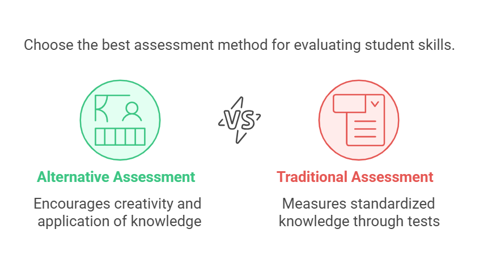Overview of Alternative Assessment
Definition and purpose
Alternative assessments are educational evaluation methods that emphasize the application of knowledge and skills in real-world or meaningful contexts, moving beyond traditional standardized testing.
Alternative assessment encompasses various methods that differ from traditional standardized tests. Alternative assessment includes approaches like integrative and holistic assessment, focusing on students’ abilities to apply knowledge in novel ways. Alternative assessment “is predicated on the view whereby, the student, the text, and the context impact learning outcomes” (Janisch, Liu, & Akrofi, 2007, p. 222), and strong consideration is required to choose the most appropriate assessment to achieve the desired results.

The primary purpose of alternative assessments is to provide a more comprehensive evaluation of student learning by emphasizing meaningful tasks that reflect real-world applications. This approach aims to enhance student engagement, promote deeper understanding, and develop skills that are transferable beyond the classroom.

Many students prefer this form of assessment because it removes the stress of grades to focus on learning. Some schools also use a pass/fail system, in which a student either passes or fails a class.
Alternative assessments cater to different learning preferences and can provide a more holistic understanding of a student’s strengths and areas of improvement. Alternative assessments also encourage reflection and metacognition.
Columbus State Community College has a variety of resources and videos about alternative assessment basics. There are many examples to consider when changing assessment strategies.

Humber College: Guide for Alternative and Authentic Assessment [PDF]
The 4 Pillars of Alternative Assessment
David Clark and Robert Talbert’s book “grading for growth” identifies 4 pillars that are required for alternative grading with an emphasis on feedback. This article breaks down the 4 pillars and is written by Robert Talbert.
Alternately, David Clark talks about his experiences with alternative assessment, discusses benefits and challenges and provides concrete examples of how to apply.
You can watch the discussion in the 19-minute video below.
